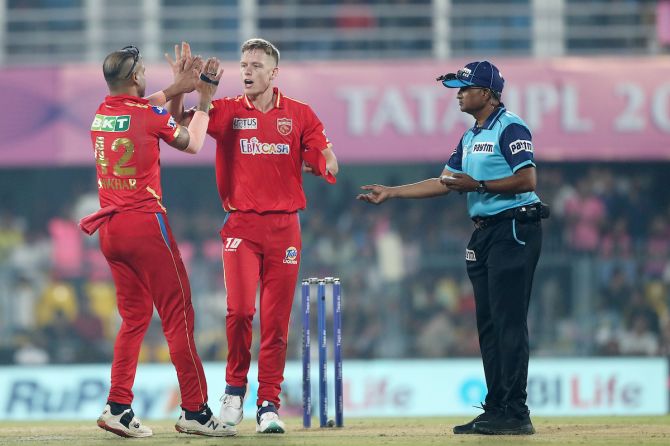
By Bharath Ramaraj
On a Guwahati pitch where batsmen from both sides made big impressions, Nathan Ellis and Sam Curran employed cross-seam bowling to tilt the balance their team’s way.
“Nothing is impossible, the word itself says ‘I’m possible’!” At first glance, that’s just a cliché. But on a very humid day in Barsapara, Punjab Kings made what seemed like a mission impossible, possible. With considerable dew around, their bowlers mixed steel with bowling smarts to trump Rajasthan Royals by a mere five runs.
So how did Nathan Ellis wade through the dewy conditions and end up with a four-for? What made Sam Curran tick in the final over under extreme duress? Let’s delve deeper to analyse the spells. To begin with, the IPL game was being played at the Barsapara Stadium in Guwahati. The city is situated 49.5-55.5.m above sea level. The weather there is mostly humid; the average humidity is 73 percent in Guwahati in the month of April. So it wasn’t surprising that during the Rajasthan-Punjab game, there was a lot of dew.
In such conditions, while defending a score of 197, Punjab’s think-tank decided to employ cross-seam. It is all good to lay out a strategy but it still has to be executed, and in Ellis they found the right candidate to put the plan into action. The first delivery itself that Ellis bowled was cross-seam. However, he ended up offering a modicum of width, and Sanju Samson cut it to the boundary hoardings. To make matters worse for Ellis, he was smashed for another boundary the very next ball.
Ellis, though, didn’t waver from his plan of bowling cross-seam, and soon bagged the key scalp of Jos Buttler. It is true that the wicket came on the back of a stunning return catch by Elllis. But the line was straighter and that meant Buttler couldn’t free his arms, as he edged one back to the bowler. Ellis also accounted for the wicket of Samson. Unlike before, Samson wasn’t able to make use of the width as he skewed one to the fielder stationed at long-off. Ellis then dislodged Riyan Parag and Devdutt Padikkal as well with his cross-seam variation.
Despite Ellis ripping through Rajasthan’s batting order, Shimron Hetmyer and Dhruv Jurel put a spanner into Punjab’s works with a quickfire alliance. Eventually, the equation came down to 16 runs off six deliveries, and the onus was on Curran, the IPL’s most expensive buy, to defend it. Until that over, Curran didn’t exactly have a good time with the ball in hand. He had already given away 35 runs, and a catch was fluffed off his bowling.

Curran, however, duly raised his game when Punjab needed him the most. He twinned very full deliveries and low full tosses, with a line that was outside the reach of Hetmyer and Jurel’s hitting zones. He also watched the feet of the batter right through his delivery stride. The way he outsmarted Jurel’s attempt to play the scoop by bowling a delivery outside the off stump illustrates that.
Curran shared his views about bowling in tough conditions to the official broadcaster. “I think when it comes to these situations, it is do or die,” he said. “If you know the yorker, you’ve got to use it. Some days, it would work and some days it won’t. They changed their ball during the end of their innings. But we weren’t able to. Amazingly hard to bowl with the wet ball. It is incredibly hard to hold the seam. It is naturally hard to bowl a yorker with a cross seam.”
In conditions where bowlers found it tough to grip the ball, Ellis and Curran used cross-seam extensively. But what is the advantage of employing cross-seam over the normal seam-up delivery with dew around? The mechanics of cross-seam delivery is to turn the ball in the hand, with the seam running horizontally across the fingers. So if the ball lands on the seam, it could kick up or bounce a touch. If it doesn’t, the ball might skid on or stay on the lower side. Basically, it brings in a little bit of unpredictability.
On the other hand, holding the ball just seam-up in dewy conditions could result in the ball skidding nicely on to the bat. To illustrate the point further, Buttler, Samson and Parag were done in by deliveries that skidded off the surface, while Padikkal was dismissed by a delivery that seemed to bounce a little extra.
On a night when humidity touched a high of 87 percent and there was substantial dew, Punjab found a method to scrape home by the narrowest of margins. As Curran said after the match: “All that matters is we won.”




